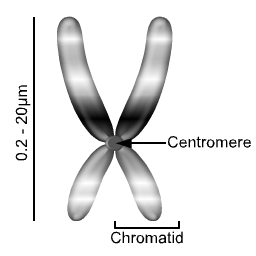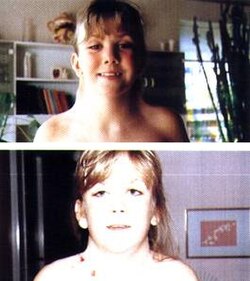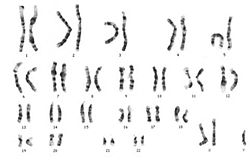X chromosome: Difference between revisions
Sawa Deguchi (talk | contribs) No edit summary |
Jakubkvasnak (talk | contribs) No edit summary |
||
| Line 1: | Line 1: | ||
__NOTOC__ | __NOTOC__ | ||
{{Checked by |20160104002340| [[User:OSeda|prof. MD Ondřej Šeda, Ph.D.]] ([[Discussion with user:OSeda|discussion]]) |399648|20180406145548}} | {{Checked by |20160104002340| [[User:OSeda|prof. MD Ondřej Šeda, Ph.D.]] ([[Discussion with user:OSeda|discussion]]) |399648|20180406145548}} | ||
[[File:Condensed Eukaryotic Chromosome.png| | [[File:Condensed Eukaryotic Chromosome.png|thumb|right|Chromosome X]] | ||
'''[[Chromosome]] X''' is one of a pair of human [[heterochromosomes|sex chromosomes]]. As a medium-sized submetacentric chromosome, it corresponds in size and shape to '''group C''. In the latest assembly of the human genome, 2327 [[genes]]s are annotated on the X chromosome <ref> {{ | '''[[Chromosome]] X''' is one of a pair of human [[heterochromosomes|sex chromosomes]]. As a medium-sized submetacentric chromosome, it corresponds in size and shape to '''group C''. In the latest assembly of the human genome, 2327 [[genes]]s are annotated on the X chromosome <ref> {{Cite | ||
|type = web | |type = web | ||
|corporation = National Center for Biotechnology Information | |corporation = National Center for Biotechnology Information | ||
| | |source_name = Homo sapiens Genome: Build 38 patch release 14 (GRCh38.p14) | ||
|year = 2022 | |year = 2022 | ||
|cited = 7/11/2022 | |cited = 7/11/2022 | ||
| Line 12: | Line 12: | ||
== Genes and Heredity == | == Genes and Heredity == | ||
[[File:Chromosome X.svg| | [[File:Chromosome X.svg|thumb|180px|Ideogram of human chromosome X]] | ||
The inheritance of genes located on the X chromosome has its own characteristics, as a woman has two X chromosomes ([[inactivation of the X chromosome|lyonization]] is used here) and a man has only one (a man is a '''[[hemizygote]]''') . We refer to this type of inheritance as [[Gonosomal recessive inheritance|gonosomal recessive]] or [[Gonosomal dominant inheritance|gonosomal dominant]]. | The inheritance of genes located on the X chromosome has its own characteristics, as a woman has two X chromosomes ([[inactivation of the X chromosome|lyonization]] is used here) and a man has only one (a man is a '''[[hemizygote]]''') . We refer to this type of inheritance as [[Gonosomal recessive inheritance|gonosomal recessive]] or [[Gonosomal dominant inheritance|gonosomal dominant]]. | ||
| Line 40: | Line 40: | ||
{{details|Turner syndrome}} | {{details|Turner syndrome}} | ||
[[File:Neck Turner.JPG| | [[File:Neck Turner.JPG|thumb|180px|right|Krk in Turner syndrome]] | ||
It is most often caused by monosomy of the X chromosome ([[Human karyotype|karyotype]] '''45,X'''), or by various loss [[Structural chromosome aberrations|structural aberrations]] (for example, deletion on the second X chromosome, etc.). Numerical and structural changes can also occur in a mosaic. Classic manifestations are: '''short stature''', '''ovarian dysgenesis'' with all the consequences, typical skin fold (''pterygium colli''). Intellect is not significantly impaired. Treatment with growth hormone and hormone replacement therapy is possible. | It is most often caused by monosomy of the X chromosome ([[Human karyotype|karyotype]] '''45,X'''), or by various loss [[Structural chromosome aberrations|structural aberrations]] (for example, deletion on the second X chromosome, etc.). Numerical and structural changes can also occur in a mosaic. Classic manifestations are: '''short stature''', '''ovarian dysgenesis'' with all the consequences, typical skin fold (''pterygium colli''). Intellect is not significantly impaired. Treatment with growth hormone and hormone replacement therapy is possible. | ||
| Line 46: | Line 46: | ||
=== Klinefelter syndrome === | === Klinefelter syndrome === | ||
[[File:47,XXY.jpg| | [[File:47,XXY.jpg|thumb|right|180px| 47,XXY]] | ||
{{details|Klinefelter syndrome}} | {{details|Klinefelter syndrome}} | ||
It is caused by the presence of an extra X chromosome in a man. It is most often caused by the karyotype '''47,XXY''', variants with more X chromosomes (48,XXXY or 49,XXXXY) are also possible, which have a more pronounced manifestation. There are also mosaic forms. The main symptoms are: '''infertility'''' (aspermia), '''hypogonadism'', average to tall height, long limbs, sparse hair, gynecomastia. | It is caused by the presence of an extra X chromosome in a man. It is most often caused by the karyotype '''47,XXY''', variants with more X chromosomes (48,XXXY or 49,XXXXY) are also possible, which have a more pronounced manifestation. There are also mosaic forms. The main symptoms are: '''infertility'''' (aspermia), '''hypogonadism'', average to tall height, long limbs, sparse hair, gynecomastia. | ||
Latest revision as of 12:51, 17 November 2023
Chromosome X' is one of a pair of human sex chromosomes. As a medium-sized submetacentric chromosome, it corresponds in size and shape to group C. In the latest assembly of the human genome, 2327 geness are annotated on the X chromosome [1]. Normally, each person receives one X chromosome from their mother. The second heterochromosome – either the X chromosome or the Y chromosome is then received from the father. In individuals with more than one X chromosome in their karyotype (that is, females and those with numerical aberrations of the X chromosome), these additional copies are inactivated in a process known as X inactivation.
Genes and Heredity[edit | edit source]
The inheritance of genes located on the X chromosome has its own characteristics, as a woman has two X chromosomes (lyonization is used here) and a man has only one (a man is a hemizygote) . We refer to this type of inheritance as gonosomal recessive or gonosomal dominant.
Pseudoautosomal regions[edit | edit source]
Certain genes are located in the so-called ``pseudoautosomal sections of the X chromosome. These are two sections - ``PAR 1 (the larger section) at the end of the short arm of the X chromosome and ``PAR 2 ' (smaller section) at the end of the long arm of the X chromosome. These genes have their homologous copies in the same order on the Y chromosome. These regions allow the X and Y chromosomes to form a "homologous" pair during meiosis; crossing-over can occur between genes in these regions. An example is the gene SHOX (Short Stature Homeobox; Xp22.32; OMIM: *312865) and its homologue the gene SHOXY ' (Yp11.2; OMIM: *400020).
Selected genes[edit | edit source]
- STS (Steroid sulfatase; Xp22.32; OMIM: *300747) - Encodes for steroid sulfatase; defect or deletion of this gene causes X-linked ichthyosis'.
- KAL1 (Kallman syndrome 1; Xp22.3; OMIM: +308700) - Encodes the protein anosmin-1; the mutation causes Kallman syndrome (central hypogonadism associated with anosmia).
- PIGA (Phosphatidylinositol glycan A; Xp22.1; OMIM: +311770) - Acquired mutation of this gene (at the hematopoietic stem cell level) causes Paroxysmal nocturnal hemoglobinuria.
- DMD (Dystrophin; Xp21.2; OMIM: *300377) - The gene encodes the muscle protein dystrophin; mutation of this gene causes muscular dystrophy of the Becker or Duchenne type.
- WAS' (Wiskott-Aldrich syndrome; Xp11.33-p11.22; OMIM: *300392 ) - A mutation in this gene causes a 'Wiskott-Aldrich syndrome (congenital immunodeficiency, thrombocytopenia, eczema).
- BTK (Bruton agammaglobulinemia tyrosine kinase; Xq21.3-q22; OMIM: *300300) - Mutations in this gene cause [ [Bruton's agammaglobulinemia|Bruton's agammaglobulinemia]] (congenital immunodeficiency).
- COL4A5 (Collagen, type IV, alpha-5; Xq22.3; OMIM: *303630) - Encodes the alpha chain [[collagen] ]in type IV, which is involved in the construction of basement membranes; mutation causes Alport syndrome (nephropathy associated with deafness).
- F9 (Factor IX; Xq27.1-q27.2; OMIM: *300746) - This gene encodes coagulation factor IX ; its mutation causes Hemophilia B.
- FMR1 (Fragile X mental retardation protein; Xq27.3; OMIM: *309550) - Mutations in this gene cause Fragile X Chromosome Syndrome.
- F8 (Factor VIII; Xq28; OMIM: +306700) - The gene encodes coagulation factor VIII ; its mutation causes Hemophilia A.
- MECP2 (Methyl-CpG-binding protein 2; Xq28; OMIM: *300005) - Mutations in this gene cause Rett syndrome (autism, stereotypical hand movements, affected almost exclusively by girls).
Chromosomal Abnormalities[edit | edit source]
Turner Syndrome[edit | edit source]
It is most often caused by monosomy of the X chromosome (karyotype 45,X'), or by various loss structural aberrations (for example, deletion on the second X chromosome, etc.). Numerical and structural changes can also occur in a mosaic. Classic manifestations are: short stature, ovarian dysgenesis with all the consequences, typical skin fold (pterygium colli). Intellect is not significantly impaired. Treatment with growth hormone and hormone replacement therapy is possible.
Klinefelter syndrome[edit | edit source]
It is caused by the presence of an extra X chromosome in a man. It is most often caused by the karyotype 47,XXY', variants with more X chromosomes (48,XXXY or 49,XXXXY) are also possible, which have a more pronounced manifestation. There are also mosaic forms. The main symptoms are: infertility' (aspermia), hypogonadism, average to tall height, long limbs, sparse hair, gynecomastia.
Syndrome 47,XXX[edit | edit source]
Chromosome X trisomy, also called Triple X syndrome' (and formerly "Superfemale syndrome"). As the name already suggests – it is caused by the karyotype 47,XXX, it can also occur in mosaic. Karyotype 48,XXXX or 49,XXXXX can also occur very rarely, these cases have a different and more serious manifestation. The 47,XXX syndrome itself does not have a distinct clinical picture, some women are examined for "infertility". There may be minor psychosocial problems, such as learning problems.
Links[edit | edit source]
Related Articles[edit | edit source]
- Chromosome
- Gonosomes
- Y chromosome
- Human Karyotype
- Chromosomal aberrations
- Sex-linked inheritance
- X-linked inheritance
References[edit | edit source]
- ↑ National Center for Biotechnology Information. Homo sapiens Genome: Build 38 patch release 14 (GRCh38.p14) [online]. ©2022. [cit. 7/11/2022]. <https://www.ncbi.nlm.nih.gov/genome/?term=Human>.







